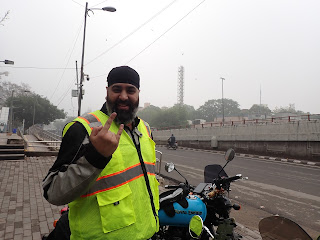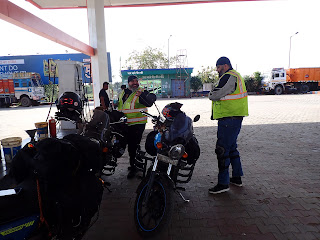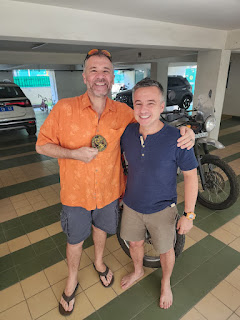Alternate titles: A Salvaged Motorcycle Adventure; 3 Idiots; Nepal No, Possibly Punjab
There they were in the dark garage: The Royal Enfield motorbikes, quiet in the Delhi morning before the heat, traffic and city noises changed everything. I’d prepped mine—a 411 Scram—the night before. Julio’s well-ridden 350 Meteor sat beside mine, ready to go. We would meet Deepak on his 500 Thunderbird soon.
“You ready?,” he asked.
“Oh, yeah,” nodding, smiling. “And then some.”
The Nepal ride we’d scheduled through the Himalayas and Lower Mustang was a bust. In short, I got really sick and was in a Delhi hospital for 5 days. We lost our tour deposits and that was discouraging.
While recuperating, friends put together a plan for a make-up ride to salvage the vacation and get me back on 2 wheels. They came up with a weeklong ride through northern India that they’d wanted to do and the route they’d planned would be perfect for a recovering motorcycle enthusiast.
So, feeling like a million rupees, I loaded up the bike, packed my antibiotics, and set off for the Punjab and Pakistani border.
We joined Deepak outside the city and the three of us negotiated the New Delhi streets, already getting busy as the sun came up, as we made our way north and west.
Cows, dogs, monkeys and people in the roads. All the time.
The Tail of the Dragon, a cool mountain pass along the North Carolina—Tennessee state line, boasts 318 curves in 11 miles. I’ve done it and it’s a fantastic ride. Well, our first day of riding consisted of zig-zagging through over a thousand twists and turns on our way to Mussoorie.
Sitting at 6,600 feet, Mussoorie is referred to as the Queen of the Hills and is one of the most popular hill stations in India. And it might’ve been even more enjoyable if vehicles and people and animals weren’t constantly in my lane. Lurching, smoking, overloaded buses coming directly at you on a precarious mountain road—again and again—can be unsettling. The pollution gave way to clear blue skies and white clouds as we made our way higher and higher into the hills, passing every vehicle in our way and dodging all sorts of obstacles as we sped to our first night’s destination.
We reached our hotel by early afternoon and set out to see the town and get a bite to eat. The 180 miles we rode that first day felt like three times that distance, though the coolness that the elevation brought was welcome after the heat of the low Delhi plains.
We left our hotel in Missouri after breakfast for the hill town of Shimla, a former British summer resort in the northwestern Indian Himalayan foothills, at an elevation of 7,100’. There was a lot more zigging and zagging and dodging of people, animals and vehicles.
“Beware of darkness,” the man warned me. He was standing by an old gate on the outskirts of a small town and I had stopped to let a cow walk past. I assured him that I would take care and continued on my way, knowing that conditions were dangerous enough without riding at night. A couple days later, I would hear an alternate theory from a doctor who rides motorcycles. He stated that riding the narrow roads in the dark is safer as you can see approaching headlights. However, we agreed that the people, debris, cows and monkeys on the roads still presented problems. Even with the crazy traffic, we made good time, though the 160 mile ride took us 10 hours.
We left Shimla’s brisk climate en route to Amristar after a quick breakfast. The first part of the day’s ride consisted of dropping down into a much lower elevation and the hot, arid climate of northwestern India’s Punjab. Hemp is prolific along the roadsides and it was interesting to see it taking over, everywhere, like the weed it was.
Deepak had been experiencing rear brake problems and we’d visited three or four Royal Enfield shops to get it fixed. While the repairs delayed us a bit, Royal Enfield offers comfortable customer lounges where we sipped masala tea as we waited.
After negotiating what seemed like 6 hours of continuous twisties, we found ourselves on fairly straight, albeit crowded, roads. We arrived to our hotel—in the middle of a quasi-amusement park—by 4 PM.
The hotel was smack in the middle of a recreated early 1900’s Punjab village. Many Indian families were enjoying the sights, sounds and food of traditional Punjabi culture. I spoke with several other guests, many of whom were Sikhs, wandering around the sprawling grounds like we were. We smiled and laughed as we exchanged questions about our respective cultures and posed for photos. I never walked away without a firm handshake and a heartfelt hug from men with swords on their hips.
On our second day, we traveled 20 miles up the Grand Trunk Road to the Pakistan border to see the Attari—Wagah border ceremony. The name Wagah refers to a village in Pakistan through which the border between India and Pakistan was drawn during the partition at the time of Indian independence in 1947. The eastern half of the village remains in India while the western half is in Pakistan.
Despite a tense political relationship, both countries come together every sundown to produce a zealous, passionate ceremony that marks the nightly lowering of each country’s flag and the closing of the border. I didn’t know what to expect but what I witnessed was choreographed chaos: My turban-wrapped head was spinning; it was just too much to capture at once. Over 45,000 Indians (and many fewer Pakistanis) cheering on the ostentatiously-dressed soldiers on both sides. For a brief moment, the conflicted countries were unified in an epic and intricate dance-off.
After a 2-day stay in Amristar, we rode southeast for our next night’s stay in Kapurthala, known as the Paris of the Punjab. Upon checking into the hotel, a driver arrived to show us the town and we told him we wanted to see some interesting, non-touristy places. After thinking for a moment he asked if we’d be interested in visiting the Rail Coach Factory…and we all were. He made some calls to high-level people and the security personnel allowed us in to explore the entire train factory. And what a fascinating, large scale operation it was. We walked through acres of warehouses unhindered by workers as we admired the trains and climbed inside for photos. It was truly something to witness.
We then headed over to the Jagatjit Palace, former residence of the Maharaja of the State of Kapurthala, Jagatjit Singh. The structure, modeled after the Palace of Versailles, was built in 1908 and is now used to train boys for the National Defense Academy. Still beautiful with its pink exterior and chiseled cherub statues, it has sadly fallen into a state of disrepair.
We were scheduled to meet up with some of Julio’s friends and that meant a long night of drinking and eating. While I’m on that subject, I can confidently state that Indians can party like no other people. World class drinkers and dancers. Super fun folks.
As well, the Indian culture has a style of eating that’s much different than anything I’ve ever seen. First, many, many plates of food are brought out later in the evening…maybe 8:30 or 9 PM; paneer (fresh Indian cheese), momos (steamed filled dumplings with origins from the Himalayan region), khichdi (a rice and lentil dish), saag (a leafy vegetable dish—spinach in this case—eaten with bread such as roti or naan), chicken tikka masala (roasted marinated chicken chunks in a spicy sauce), dal makhani (Indian lentils and kidney beans), tandoori chicken (chicken marinated in yogurt and spices and roasted in a tandoor, a cylindrical clay oven), biryani (mixed rice), various curries and several other dishes. Then, shortly after everyone has eaten their fill, the host will ask—in all seriousness—if the guests are ready for dinner. I truly thought it was a joke the first time. But after filling up on “appetizers” a second time, I learned to pace myself over 3-4 hours of eating. It’s something to behold.
It was a long evening of music, dancing, laughing, food and vodka at an old, stately mansion once owned by a maharaja and a prime minister; the current resident is one of Julio’s friends. There’s a lot of history to the place and everyone was certain it was haunted.
They say there are three trips you take to India: the one you think you’re going to have—that you plan for; the one you actually have; and the one you live through once you go back home. I’ve found this to be quite true.
We were to go from Kapurthala to Firozpur—an India–Pakistan border town—the next day but plans changed so we decided on heading to Chandigarh instead. While at a Royal Enfield dealer in Jalandar, having Deepak’s brakes looked at once again, we all decided to skip a night in Chandigarh and make it home that evening. Instead of a 3-hour ride, we would have a long 9-hour day…but would sleep in our own homes. We prepared ourselves for the 400 KM ride by hydrating and checking the GPS directions, then roared off on a southeasterly route on a decent toll road.
Coming into Delhi
We saw the smog hanging in the sky, dark and ugly, from miles away. We were getting closer to home and the haziness blurred the sun. We stopped to put on N-95 masks but even with the mask on and helmet face shield down, I could smell the smog. It burned my eyes and caused me to cough. Delhi pollution is legendary. It was getting dark and we were tired. It had been a long day but we still had to deal with the three traffic lanes that often had five cars across. We weaved in and out of the vehicles, using any available space to make forward progress. My GPS showed 60 KM and a 2-hour arrival time. Delhi traffic is equally infamous yet surprisingly I saw very few major accidents.
Passing by a 9-story trash pile that encompassed several acres, I knew we were getting close to downtown. Impoverished families swarmed though the refuse like ants as giant tractors sitting atop the trash heap looked like toys, dwarfed by the massive garbage pile. It was a surreal scene…but one should expect these kinds of incredible sights from India.
Dress for the fall.
Deepak waved to us as he peeled off and we continued home via a different route. We rolled into Julio’s parking garage just as the sun disappeared. It had been a long day of breathing polluted air and fighting traffic in the Delhi heat, but now we were home. As I turned to park my bike in the garage, I bumped into a small cardboard box on the ground and fell over…just 2 feet from where I was to park. I raced to lift the bike as Julio attempted to get photographic evidence. I won that contest and by the time his camera was ready, my bike was back on 2 wheels. A most excellent ending to a great ride.
My friend Camilo, AKA: Cobra 1, leader of New Delhi’s Cobra Chai motorcycle club, says that if you ride in India, you must Ride Hard, Blow Horn and Survive.
And, boy…I sure did that.
Here are some ride stats:
Trip duration: 6 days
Days of riding: 5
Total mileage: 1,400 KM +/-
Highest elevation: 7,400’
Longest day: 400 KM (9 hours)
Shortest day: 30 KM (2 hours)
Mechanical issues: 1 (repeatedly)
Flat tires: 0
Accidents: 0
Police encounters: 1
Bikes dropped: 2 (no photo/video proof)

















































































































Great ride report, glad you're (both) home safe and are on the mend from that excursion. I'll have to get the "Rest of the Story" later over a beer or two. (if your stomach can handle that)
ReplyDeleteTL:DR but nice pictures
ReplyDelete
ReplyDeletefor cleaning services contact us.
House Cleaning Services Near me